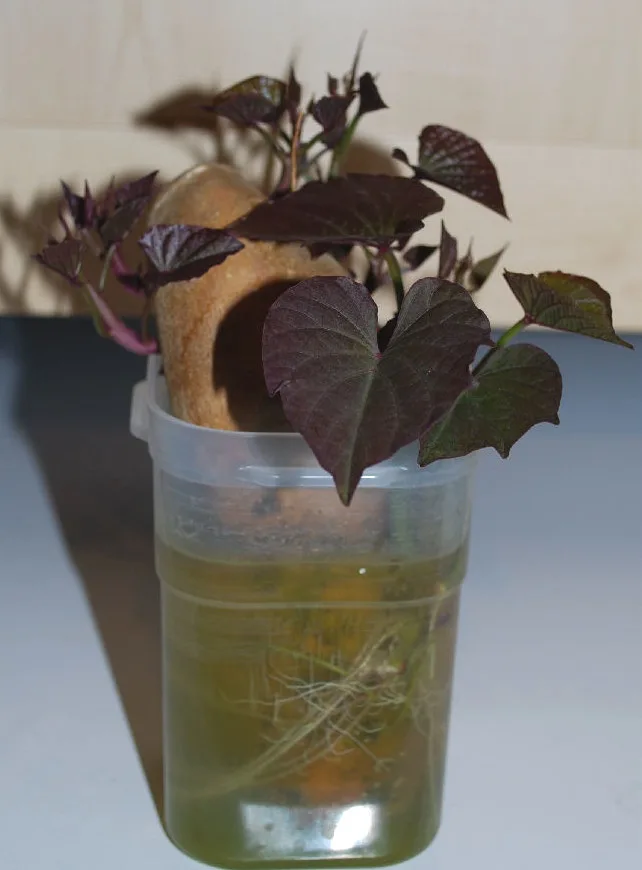How To Grow Sweet Potatoes In The UK
In the world of UK home gardening, sweet potatoes (Ipomoea batatas) are not a particularly common crop. Their rich taste and nutritional value does however make them an increasingly desirable choice for gardeners. If you’re planning on cultivating them in the UK, be prepared though for a long slow process and an unpredictable crop.
Before learning how to grow sweet potatoes, it’s important to understand that they’re a warm weather crop originating from Central or South America. Growing them outdoors is feasible (at least in the south of the UK with its slightly warmer climates), but is always going to be something of a lottery. If we have a hot summer, you may get a worthwhile crop. If the weather is poor, it’s entirely possible the plants will fail to develop tubers of any worthwhile size.
Growing in a greenhouse or polytunnel is likely to be more successful, especially for growers further north. Expect to have to provide plenty of water though, as it’ll be needed to help develop the tubers and keep the extensive foliage healthy.
Choosing the Best Varieties
Before we delve into the nitty-gritty of cultivating sweet potatoes, it’s important to choose the right variety that suits your growing conditions and preferences. In the UK the most popular varieties are ‘Beauregard Improved’, ‘Bonita’ and ‘Muraski’, which are all well suited to our climate.
Starting with Slips or Plug Plants
Unlike traditional potatoes, sweet potatoes are typically grown from slips or plug plants, which are young plants that have been grown from the potato’s sprouts. Slips are sprouts that have been removed from a mature sweet potato and allowed to grow roots.
Plug plants are ready-to-plant young sweet potato plants that can be purchased from garden centres or mail order suppliers. Opting for either method depends on your preference and the time you have available.
Cultivating Slips Yourself
It’s possible to grow your own sweet potato slips, by suspending a regular supermarket tuber in water, with half beneath water and the rest in open air.
After a period of time (possibly as much as months), the tuber will start to produce shoots. Once these are a few inches long, they can be broken off, planted in good quality potting compost, and kept very moist and they’ll start to produce roots. After a bit of growing on, so that they’ve had a chance to develop plenty of roots, they’ll be ready to plant outdoors, in a polytunnel, or greenhouse. Keeping the developing slips in a warm propagator may help to accelerate growth. If you don’t have a propagator, place them on a warm windowsill, preferably one which faces south.

A sweet potato suspened in water developing some nice healthy shoots. In this case, the tubers were placed in water around Christmas time, which was possibly too early and which resulted in some pretty murky algal growth in the pot!
This whole process can be very slow. I used to use Valentine’s day as a reminder when to put tubers into water. It may be worth experimenting with “planting” in water sooner, but I found that when doing so, the tubers just sat dormant or, worse still, started to rot, presumably due to lack of warmth, or too short day length.
Another down-point to growing your own slips is that the variety may be unknown. The tubers you’re trying to grow from may be a variety completely unsuited to the UK. Possibly worse, if you find they grow really well, you might struggle to get hold of the same variety for the following year (so remember to try and store a tuber or two for cultivation!). Some people may enjoy the challenge of growing slips, but if you want to stand the best chance of seeing an excellent crop, shop bought slips may be a safer option.
Ideal Planting Conditions
Sweet potatoes thrive in warm climates and full sun, so choose a well-drained growing area in your garden that receives at least 6-8 hours of sunlight per day. The ideal location will have loose, sandy soil with good drainage, and be rich in organic matter. Prior to planting, work compost into the soil to improve its fertility and drainage. Avoid areas with compacted or waterlogged soil, as sweet potatoes dislike these conditions.
Planting the Slips or Plug Plants
When the risk of frost has passed and the soil has warmed up to around 60°F (15.5°C), it’s time to plant your sweet potato slips or plug plants. Create rows or mounds in your garden bed, spacing the plants about 12 to 18 inches apart (30-45cm). Bury the slips or plug plants about 2-3 inches (50-75mm) deep in the soil, leaving the top set of leaves above the soil surface.
For optimal growth and tuber development, you can apply black polythene or weed membrane around the plants. This not only helps to warm the soil further but also suppresses weeds and conserves moisture.
Caring for Young Plants
Young sweet potato plants require constant care to ensure their healthy growth and development. Keep the soil consistently moist but not waterlogged, as excess water can lead to rot. A layer of organic mulch, such as straw or wood chips can help maintain soil moisture and regulate temperature.
Fertilise your sweet potatoes about a month after planting using a balanced fertiliser. Avoid excessive nitrogen, as it can promote excessive vine growth at the expense of tuber formation. Instead, opt for a fertiliser with a higher potassium content to encourage root development.
Managing Potential Frost Risks
Sweet potatoes are highly sensitive to frost, which can damage or kill the plants. If you’re in an area with a risk of late spring or early autumn frost, consider using row covers or cloths to protect your young plants. These covers can provide a few extra degrees of warmth, helping your sweet potatoes survive chilly nights.
Vine Care and Pruning
As your sweet potato plants grow, they will develop sprawling vines that can quickly take over your garden space. To manage their growth and encourage tuber development, gently train the vines to spread out or climb on supports. Prune any overly dense foliage to allow for better air circulation and light penetration, which reduces the risk of diseases.
Harvesting Your Bounty
The excitement of growing sweet potatoes culminates in the harvest. Most sweet potatoes are ready to be harvested 90 to 120 days after planting, depending on the variety and growing conditions. The signs of readiness include fully matured foliage and the appearance of larger tubers beneath the soil.
Use a digging fork or shovel to carefully unearth the sweet potatoes. Be gentle to avoid damaging the delicate tubers. Once harvested, allow the sweet potatoes to cure for about a week in a warm and humid environment. This process allows the skins to toughen up and the flavors to develop fully.
Common Problems and How to Address Them
While sweet potatoes are relatively robust plants, they can still face a few challenges along the way. Here are some common problems you might encounter and tips on how to address them:
1. Pests: Sweet potatoes can attract pests such as sweet potato weevils, aphids, and whiteflies. Regularly inspect your plants for signs of infestation and use organic pest control methods, such as neem oil or insecticidal soap, to manage the issue. Foliage doesn’t generally tend to attract birds, but may get eaten by rabbits, so fence or net plants to protect against this if necessary.
2. Diseases: Some diseases like root rot and fungal infections can affect sweet potatoes. Practice good garden hygiene, avoid over-watering, and choose disease-resistant varieties to prevent these problems.
3. Weeds: Weeds can compete with sweet potatoes for nutrients and water. Mulching and regular weeding can help keep weed growth under control.
4. Vine Borers: These pests can damage the vines and lead to decreased tuber production. To combat them, wrap the base of the vines with aluminum foil or use physical barriers to prevent their entry.
Conclusion
Growing sweet potatoes can be an incredibly satisfying and delicious endeavour. From selecting the best variety to nurturing young plants, managing potential issues, and finally harvesting your bounty, the process is a true labour of love. By following the steps outlined in this guide, you’re well-equipped to embark on your sweet potato-growing journey. Remember that gardening is a dynamic learning experience, so don’t be discouraged by setbacks. With patience, care, and a bit of sunshine, you’ll soon be enjoying the fruits of your labour in the form of sweet and nutritious homegrown sweet potatoes.



